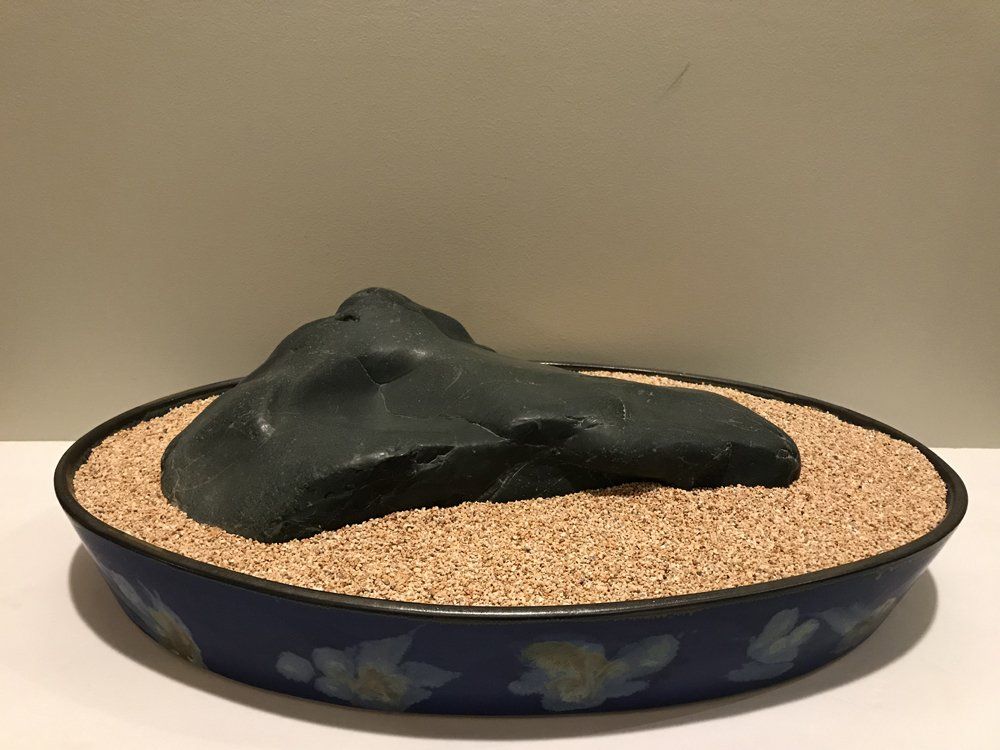Collecting Stones in Northern CaliforniaCollecting Stones in Northern California Rivers
By Les Allen, January, 2020
Viewing stones from northern California are known throughout the world as they have been exhibited in bonsai and stone exhibitions in Japan, Europe, and throughout North America. The complex geological history of northern California has produced an array of beautiful and unusual stones. Beautiful green serpentines, black basaltic rocks, jades often mixed with other minerals, and colored jaspers that resembles Japan’s Sado island Akadama stone, and others can be found in the many rivers and streams of this region of California. The rivers originate high in the Sierra Mountains and mainly run westward to the Pacific Ocean or to the southwest.
(l): Black Butte River. (r): Black Butte Stone
I made my first collecting trip in northern California in 1999 by connecting with members of the California Suiseki Society in the San Francisco Bay area. This club was established in 1993, much later than the other two clubs founded by Japanese collectors. I try to go stone hunting in northern California each year. The combination of the fresh air, exercise and beauty of the scenery adds to the excitement of finding a nice stone. I also found that the more one collects, the better one’s eye improves for finding good viewing stones along a river.
Searching for interesting stones began in the Sacramento and San Francisco areas in the early to mid-1950s. This is documented in Felix Rivera’s book Suiseki, The Japanese Art of Miniature Landscape Stones. Members of clubs were initially Japanese-only stone enthusiasts. Later, clubs consisting of Caucasians and Asian Americans, joined in the search for viewing stones. The early Japanese stones collectors made great finds in the Kalmath, Trinity, and Eel Rivers. The Eel River became the most popular and best-known place to collect stones because of the diversity of stones along that river. Some of the other good collecting sites in northern California include Thomes Creek, Cache Creek, Black Butte River, Stony Creek, the Salmon River, Russian River, Merced River, and the American River.
(top l): Salmon River Stone. (top r): Eel River stone collected by Henry Van der Voort.
(bottom): Eel River Chrysanthemum Flower stone collected by Henry Van der Voort. The Eel River has yielded several nice chrysanthemum stone flowers over the last several decades but they remain elusive. This is the primary site for these stones in North America.
I recommend that anyone interested in collecting stones in northern California should do so with members of a California-based stone group. It is important to know the laws regarding collecting stones on public properties and having permission to collect on private lands. There are several suiseki and viewing stone organizations throughout California that schedule regular meetings, exhibitions, and occasional collecting trips. You can join any of these groups and receive their mailing distributions for future events. May through October are generally the best months to collect in northern California. The water levels tend to be higher with faster flows in the other months. Avoiding severe weather in the mountains and rivers is imperative.
Thomes Creek and Thomes Creek stones
There are several books which prominently feature Northern California stones. These include Rivera’s book mentioned above, the San Francisco Suiseki Kai 25th Anniversary exhibition catalog
(2007), Jim Greaves’ American Viewing Stones Beyond the Black Mountain
(2008), Thomas Elias’ Viewing Stones of North America
(2014), and the California Aiseki Kai, Celebrating the Twenty-fifth Annual Exhibition at the Huntington
(2014). Additional publications promoting Northern California stones include the California Aiseki Kai Newsletter,
Golden Statements, and BCI’s Bonsai and Stone Appreciation
magazine.
If you are anticipating collecting stones in Northern California, it is best to always go with at least one other person in case of an accident, wear proper shoes, and bring a hat, sun screen, and equipment such as a back pack, crow bar, and stiff brush. To reach Northern California collecting areas, the Sacramento, Oakland, and San Francisco airports are the closest, but understand that it will take an additional two or three hours by car to reach many of the collecting areas. So, pack your bags and happy hunting.



